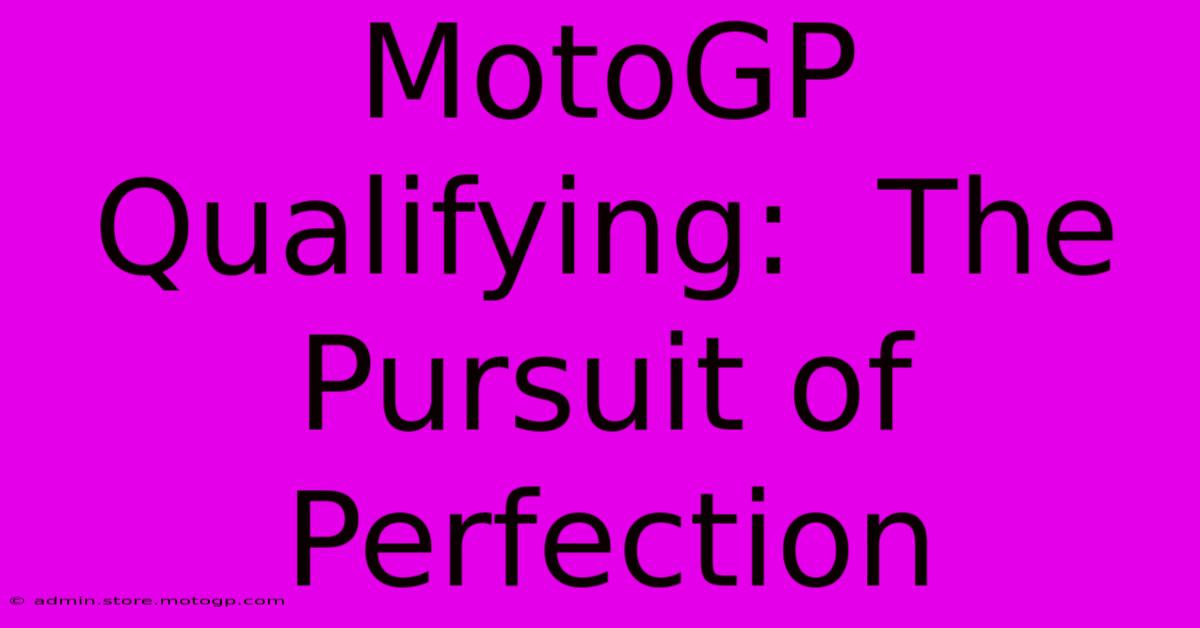MotoGP Qualifying: The Pursuit Of Perfection

Table of Contents
MotoGP Qualifying: The Pursuit of Perfection
MotoGP qualifying. The phrase itself conjures images of screaming engines, breathtaking speed, and the intense pressure of riders vying for the ultimate advantage – pole position. It's a crucial stage of the Grand Prix weekend, a high-stakes battle where milliseconds separate triumph from disappointment. This article delves into the intricacies of MotoGP qualifying, exploring the strategies, the technology, and the sheer human determination required to secure that coveted front-row spot.
Understanding the Qualifying Format
The current MotoGP qualifying format is designed to be dramatic and maximize viewing engagement. It unfolds over two sessions:
Q1 (Qualifying 1): The Initial Showdown
The riders who haven't achieved a top-ten spot in the combined Free Practice sessions (FP1, FP2, and FP3) start in Q1. This session is a frantic 15 minutes where these riders battle it out for the two coveted spots that lead to the next stage, Q2. The pressure is immense; a single mistake can be the difference between progressing and starting further down the grid. Strategy is key here: riders might opt for a softer tire for a quick lap, risking wear for the race, or prioritize a more consistent pace.
Q2 (Qualifying 2): The Fight for Pole
The top ten riders from the combined Free Practice sessions, along with the two qualifiers from Q1, enter Q2. This is where the true battle for pole position takes place. The tension is palpable; every tenth of a second counts. This 15-minute session is a high-stakes dance between rider skill, bike setup, and the ever-present threat of a crash. The rider with the fastest lap time claims pole position, securing a significant advantage for the race.
The Key Ingredients for Qualifying Success
Several factors contribute to a successful MotoGP qualifying performance:
1. Rider Skill: The Human Element
While technology plays a massive role, the rider's skill remains paramount. Precision, control, and bravery are essential attributes. Riders must push their machines to the absolute limit, navigating the track with pinpoint accuracy, while managing tire wear and fuel consumption. Mental fortitude is equally crucial, as the pressure of qualifying can be immense.
2. Bike Setup: The Machine's Contribution
The bike's setup is crucial for optimizing performance in qualifying. Teams spend countless hours tweaking settings, fine-tuning suspension, aerodynamics, and engine mapping to extract every ounce of potential from their machines. The balance between speed and stability is a delicate act, often requiring compromises depending on the track characteristics.
3. Tire Management: A Strategic Gamble
Choosing the right tires for qualifying is a crucial strategic decision. Soft tires offer superior grip and speed, but wear out faster. Harder tires are more durable but sacrifice some performance. Teams must balance the need for a fast qualifying lap with the requirements of the race.
4. Track Conditions: The Unpredictable Variable
Weather conditions can drastically alter the qualifying landscape. Rain can dramatically reduce grip, changing the optimal riding line and forcing riders to adapt quickly. Even subtle changes in temperature and wind can affect performance, making adaptability and flexibility vital.
5. Slipstream: The Aerodynamic Advantage
In MotoGP, slipstreaming can provide a significant time advantage. By riding closely behind another bike, a rider reduces wind resistance, allowing them to achieve higher speeds. The strategic use of slipstreams, known as "towing," is a common tactic in qualifying, adding another layer of complexity to the battle.
Beyond the Timing Screens: The Impact of Qualifying
Securing a strong qualifying position is far more than just bragging rights. It significantly influences the race outcome:
- Better Starting Position: Pole position provides a crucial advantage at the start, allowing riders to control the race from the front.
- Race Strategy: A good starting position allows for a more flexible race strategy, allowing riders to conserve tires and fuel.
- Track Position: Leading the pack in the early laps grants access to cleaner racing lines, making overtaking maneuvers easier.
MotoGP qualifying is a microcosm of the sport itself: a demanding, high-stakes pursuit of perfection where human skill, technological innovation, and strategic acumen converge. It's a captivating spectacle that leaves viewers on the edge of their seats, waiting to see who will conquer the challenge and claim the ultimate prize: pole position.

Thank you for visiting our website wich cover about MotoGP Qualifying: The Pursuit Of Perfection. We hope the information provided has been useful to you. Feel free to contact us if you have any questions or need further assistance. See you next time and dont miss to bookmark.
Featured Posts
-
Ex Factory Race Bikes Built To Win
Feb 19, 2025
-
Race Bikes For Sale Find The Perfect Bike For You
Feb 19, 2025
-
Your Cota Parking Solution Lot T
Feb 19, 2025
-
Formula 1 Parking The Smart Way To Park
Feb 19, 2025
-
Moto Gp 23 Ps 5 Prepare For The Ultimate Racing Thrill
Feb 19, 2025
